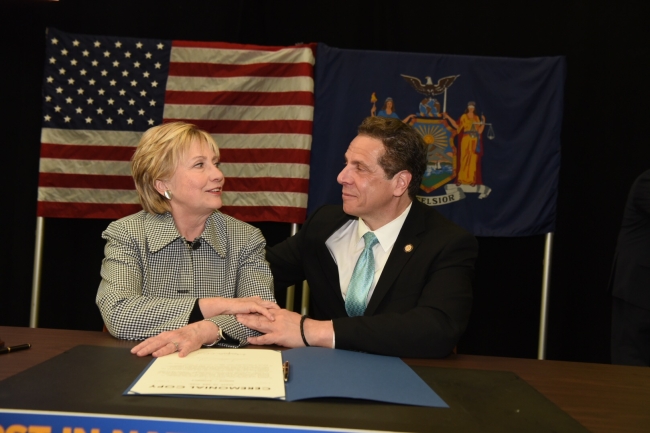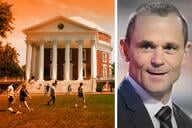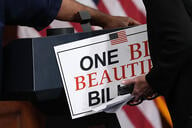You have /5 articles left.
Sign up for a free account or log in.

Hillary Clinton and New York Governor Andrew Cuomo appeared Wednesday at a ceremonial bill signing for New York's free public college tuition program.
New York governor's office
New York’s freshly signed free public tuition program puts the squeeze on many of the state’s weakest private colleges and universities.
Private college presidents know it. But most aren’t yet sure what to do about it.
Those presidents reacted with a mix of dismay, confusion, criticism and, in some cases, resolve in the days after New York leaders struck a deal to start a tuition-free public college program this fall. The creation of a program in New York caps a winding and unexpected path for the free-college idea, which New York Governor Andrew Cuomo proposed early this year after it appeared to have died with Hillary Clinton’s presidential bid. Cuomo held a ceremonial bill signing for the program Wednesday, which Clinton attended.
The program, called the Excelsior Scholarship, will allow New York residents from families earning up to $125,000 per year to attend the state’s public community colleges and four-year colleges without paying tuition. It will go into effect this fall for students who are newly enrolling at institutions in the State University of New York and City University of New York systems and who come from families with incomes of up to $100,000 per year. The income limit will jump to $110,000 in fall 2018 and $125,000 in 2019. Cuomo’s office estimates that about 940,000 families in the state will be eligible at that point.
The program poses a significant challenge for New York’s many small private institutions, which suddenly find themselves facing a new kind of competition and increasing inter-sector warfare in the state. The pressure will be highest on tuition-dependent colleges and universities that already compete for students in part by heavily discounting their tuition and that draw most of their students from inside the state. More prestigious colleges and universities, which pull in more students from out of state and are more selective in their admissions, are less likely to feel a major pinch.
But experts warned that all private institutions in New York should take this moment to evaluate their strategies for the future. Some will have to find ways to keep the doors open in a suddenly more competitive landscape, and all should be aware of where they stand in a market that has suddenly been upended.
“I think the only outcome that’s certain from this initiative is that it has thrown the marketplace into confusion,” said Charles L. Flynn Jr., president of the College of Mount Saint Vincent. The college, located in the Bronx, draws about 80 percent of its 1,600 undergraduates from within New York State.
“We don’t know how it would work, we don’t know how it can work and we certainly don’t know how it will affect individual families,” Flynn said of the free-college program.
Private colleges would seem to have a few strategies available if they want to attract students who are newly considering public institutions. One is that they could throw more financial aid at students who are on the fence.
Not everyone has the money available, however. Mount Saint Vincent already has a freshman tuition discount rate in the high 50 percent range, Flynn said. The national average tuition discount rate for first-time, full-time freshmen is 48.6 percent, according to the most recent report from the National Association of College and University Business Officers.
“How can I go above that?” he said. “We don’t have a lot more aid to throw.”
The college can survive in the event its enrollment dips this fall, Flynn said. But he can’t yet rule out having to take steps like layoffs if enrollment drops substantially. And he said Mount Saint Vincent is in better financial shape than many other private institutions in New York. He has heard talk of some institutions already preparing for layoffs in the wake of the free-tuition bill passing, he said.
SUNY and CUNY do not yet have estimates for how much the free-college program will boost fall enrollment, spokeswomen for the systems said. A March report from the Commission on Independent Colleges and Universities in New York projected that public institutions would see an enrollment increase of between 9 percent and 22 percent under Cuomo’s plan.
The report went on to estimate that enrollment in the state’s private nonprofit colleges and universities would fall by between 7 percent and 15 percent under Cuomo’s plan. That would cost private institutions a collective $1.4 billion in revenue, representing a major shift in student behavior and hitting institutions with diverse student bodies especially hard.
New York is home to more than 100 private nonprofit colleges and universities enrolling about 300,000 students from within the state, according to CICU. Just over half of the state’s colleges have student bodies that are at least 75 percent New Yorkers. Close to 90 enroll fewer than 2,000 students.
In other words, many tuition-dependent colleges would be at risk of missing critical enrollment targets if public colleges’ free tuition draws even a few students away from them. Those colleges are likely already financially strapped and can least afford to see sudden drops in enrollment.
“Once this is out there and implemented, possibly some of the more precarious institutions will go under,” said Gary Olson, president of Daemen College, near Buffalo, which enrolls about 2,700 students -- 2,000 of them undergraduates, 90 percent of whom come from New York State. “And what that will do is cause millions of dollars of lost economic impact on the local community where the college is located.”
Daemen’s full-time undergraduate tuition sticker price is $26,400 for the 2016-17 academic year. It’s possible that the college will have to increase its tuition discount rate to attract students, Olson said. The college’s discount rate is currently in the low 40 percent range for freshmen.
Olson wasn’t ready to commit to raising the discount rate, however. Daemen is more likely to argue that it provides a better education than its public competitors.
“What we’re likely to do is play the quality card,” he said.
Olson also argued that there are several problems with the Excelsior Scholarship that will ultimately disappoint students. The program requires students to graduate on time. It also requires recipients to live in New York for the same number of years they received free tuition -- otherwise, the scholarship amount will turn into student loans.
Time will tell if Olson’s argument proves true. But even if it does, it won’t help colleges and universities that can’t survive a year or two of lower enrollment.
Such a college or university could attempt to recruit more students from outside of the state. It could also attempt to draw more students from upper-middle-class or wealthy families who do not qualify for the Excelsior Scholarship.
Those aren’t necessarily reasonable propositions, however. Many private colleges or universities would be enrolling more out-of-state or wealthy students if they were able to.
Experts said that in the short term, the discussion is likely to keep coming back to the idea of price.
“The challenge for private institutions is that all of this media is out there touting free tuition,” said Craig Goebel, a principal at the Baltimore-based strategy consulting firm Art & Science Group. “My fear for the private institutions is that even students who won’t be eligible for this program will be swayed to pursue public education on a misunderstanding of what’s going on.”
Private colleges might have to take their evaluation of price beyond tuition discounting.
“Pricing strategies are probably going to be a hot topic on some campuses,” said Wes Butterfield, vice president overseeing the financial aid services division of the consulting firm Ruffalo Noel Levitz. “This is part of the reason we’ve been moving to this environment: because of cost. We’re talking about the initial sticker price. Maybe this is an opportunity for campuses to take a look.”
Butterfield cautioned against focusing too much on price, however. Private colleges and universities need to examine their mission, vision and values in order to better position themselves in the market, he said.
“You have to look at what you do and make sure you are tightening up that aspect of your institution, first and foremost,” he said. “Take a look at your programs and make sure you are providing students strong outcomes. That’s the easiest and the hardest thing to do in some respects, but it allows you to take some of that pressure off of the cost piece.”
Private colleges in New York should have been taking a hard look at their strategies even before the free-tuition program became law, said Sarah Coen, senior vice president at Ruffalo Noel Levitz. Strategic enrollment plans can’t ignore student demographic and economic trends, she said. Many of those trends do not favor parts of New York State.
Coen suggested that colleges focus on retention as they face increasing competition for new students.
“If there is more concern of losing the incoming student, then what are these private institutions doing?” Coen said. “It’s a really good time to make sure your current students know how much you love them and want them to stay.”
Presidents will have to strike a delicate balance between the triage of making sure their colleges and universities survive in an unsettled market and the long-term planning that is necessary to set them up for the future.
“Institutions that are relying on big discounts and financial aid to enroll a class, they’re going to be in trouble,” said Rick Hesel, a principal at Art & Science. “The ones that have a strong, differentiated position based on substance, on the student experience, will be better off.”
Another Art & Science principal, David Strauss, warned college presidents against falling into the trap of thinking they can simply do a better job of marketing themselves. They need to take a real look at their missions and how they can strengthen them, he said.
“Acting on a cosmetic level, where we figure out how to communicate a bit better, aid a bit better, recruit a bit better, is unlikely to create real competitive balance for the institutions that will be challenged by this move,” Strauss said.
Some private college presidents suggested they could emphasize four-year graduation rates. The SUNY system’s four-year graduation rate is only 48.9 percent. But some small private colleges post four-year rates below that level. Other presidents said they could compete on indicators like economic mobility, class size and levels of academic support offered.
“You just have to look at this thing and say, it is what it is, how do we make the best of this?” said Kenneth Macur, the president of Medaille College in Buffalo. “When you’re already in a position to compete on value and not on price, then you’re in a position to compete.”
Medaille enrolls about 2,100 students, about three-quarters of whom are undergraduates. More than 90 percent of the undergraduate population is from New York.
Yet Macur said he is not impressed by the free-tuition law. He described it as more hype than substance.
New York’s public institutions do not have the money or the capacity to take on a huge influx of students on short notice, he said. He went on to argue that the law effectively undermines the worth of a SUNY education by telling the public that its value is zero.
Macur also pointed to issues he has with a new grant program being created for students attending private colleges. The program offers awards of up to $3,000, but private colleges and universities have to provide matching funds. They would also have to freeze tuition for the student receiving the grant.
“Nobody has the money sitting around,” Macur said. “Keep in mind, we’re awarding 40 and 50 percent discount rates.”
Medaille’s tuition discount rate is in the 50 percent range, Macur said. The college quotes full-time undergraduate tuition in Buffalo at $27,276 per year.
New York’s private colleges had wanted Cuomo to boost the state’s Tuition Assistance Program, a grant available to students attending both public and private institutions.
“This was an opportunity where he could have built a stronger partnership between publics and privates,” said Shirley Mullen, president of Houghton College, in western New York. “This is perhaps a lose-lose that could have been a win-win.”
Houghton is a Christian liberal arts college that draws about 40 percent of its students from out of the state, Mullen said. Its student body makeup and specific identity as a Christian college make her confident about her college’s future.
“I think we are probably a little less vulnerable than schools who have a much higher percentage of their students coming from New York State,” she said. “There is also a specific reason that most families are choosing to come to Houghton. They’re coming for the strong academic programs, but also for the faith-based component.”
Also confident was Philip A. Glotzbach, president of Skidmore College, located north of Albany.
“I actually worry more now about international students, given some of the things that are going on with immigration” at the national level, Glotzbach said.
Only 29 percent of Skidmore’s students come from New York State, he said. The 2,500-student college is highly selective, accepting just 24 percent of its applicants. And it has a relatively low tuition discount rate of 32 percent for first-year students.
As a result, Glotzbach said, the free-tuition program is unlikely to cut into enrollment at Skidmore.
“Some other private schools, schools that compete more on the basis of sticker price than we do, might suffer from this,” he said. “I don’t think it will have much effect on Skidmore.”




